[press release]
National Postal Museum Announces New Exhibition Opening
Exhibition Devoted Entirely to African American History
“Freedom Just Around the Corner: Black America from Civil War to Civil Rights,” opening Feb. 12 at the Smithsonian’s National Postal Museum, is the museum’s first exhibition devoted entirely to African American history. Marking 150 years since the end of the Civil War and the abolition of slavery throughout the United States, the exhibition chronicles the African American experience through the perspective of stamps and mail.
The exhibition includes letters carried by enslaved Americans, mail sent by and to leaders of the civil rights movement and original artwork for numerous stamps issued by the United States Postal Service. More than 100 items from the museum’s collection are on display, augmented by outstanding pieces on loan from other institutions and private collections.
“The exhibition is powerful and presents a distinctive perspective to the history that unfolded during this important period of time,” said Allen Kane, director of the museum. “Our hope is that visitors will learn more about this historic period, connect emotionally to the stories and objects we are presenting and continue to have meaningful conversations beyond the museum visit.”
Before the introduction of home mail delivery, slaves often carried letters to and from the post office. Slave-carried mail was usually identified by a notation—called an endorsement—that also served as a travel pass. These mail messengers could be an important source of news if they overheard discussions during their travels. Slaves sometimes carried letters directly to the recipient, bypassing the postal system entirely. This was often the case when the letter was accompanied by a parcel, since post offices did not handle domestic package mail until 1913.
The exhibition, in part, presents examples of slave-carried mail, including one carried by a slave named Susan, dated April 17, 1850, with the message, “I send to you my negro girl Susan aged 16 all rite and a first rate girl big limbs and muscles please sell her and remit…”
Susan was probably unaware that the letter she carried to the Eastville, Va., post office contained arrangements for her to be sold to a slave dealer in Richmond.
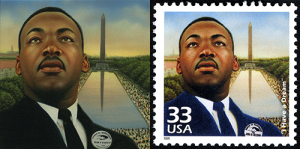 Martin Luther King’s “I Have a Dream” speech was commemorated in the Postal Service’s Celebrate the Century stamp series issued at the end of the 20th century. Original artwork for the stamp, by Keith Birdsong, reflects a trace of brightness on the horizon to represent hope, while King wears the March’s official badge, in one of many stunning paintings on display from the Postal Service’s Black Heritage stamp series. Most of the artwork is exhibited for the very first time.
Martin Luther King’s “I Have a Dream” speech was commemorated in the Postal Service’s Celebrate the Century stamp series issued at the end of the 20th century. Original artwork for the stamp, by Keith Birdsong, reflects a trace of brightness on the horizon to represent hope, while King wears the March’s official badge, in one of many stunning paintings on display from the Postal Service’s Black Heritage stamp series. Most of the artwork is exhibited for the very first time.
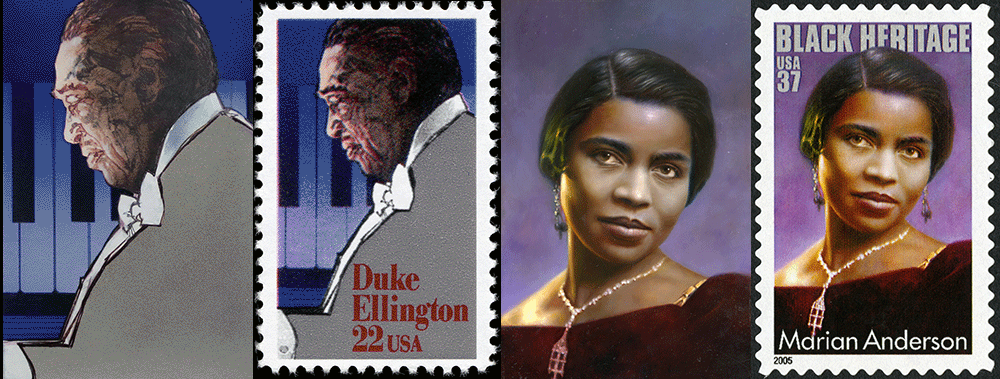 “‘Freedom’ provides a unique take on African American history, exploring the subject through stamps and mail,” said Daniel Piazza, exhibit curator. “We hope this approach inspires new audiences to visit the National Postal Museum and William H. Gross Stamp Gallery.”
“‘Freedom’ provides a unique take on African American history, exploring the subject through stamps and mail,” said Daniel Piazza, exhibit curator. “We hope this approach inspires new audiences to visit the National Postal Museum and William H. Gross Stamp Gallery.”
Selected pieces in the exhibition will include interpretation presented through audio recordings of curators, conservators and guest speakers, adding significance to individual objects. A special website and catalog will augment the exhibition as well, providing additional access to the rich content presented.
The National Postal Museum is devoted to presenting the colorful and engaging history of the nation’s mail service and showcasing one of the largest and most comprehensive collections of stamps and philatelic material in the world. It is located at 2 Massachusetts Avenue N.E., Washington, D.C., across from Union Station. The museum is open daily from 10 a.m. to 5:30 p.m. (closed Dec. 25). For more information about the Smithsonian, call (202) 633-1000 or visit the museum website at www.postalmuseum.si.edu.
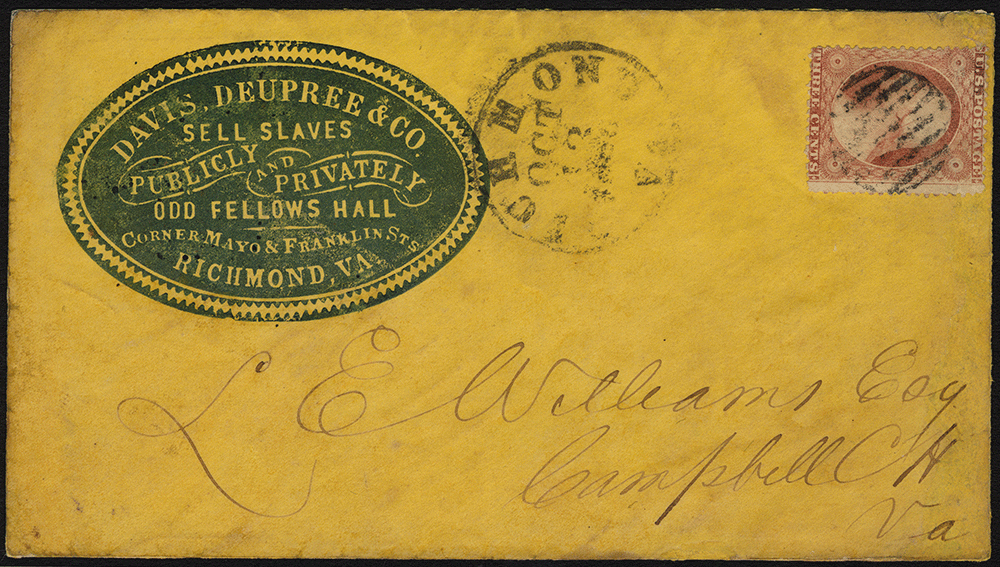 Davis, Deupree and Company cover and letter, October 13, 1860
Richmond, Virginia was the center of the domestic slave trade on the eve of the Civil War. Despite the large volume of mail that must have been sent by slave dealers, just a few examples survive today.
Davis, Deupree and Company cover and letter, October 13, 1860
Richmond, Virginia was the center of the domestic slave trade on the eve of the Civil War. Despite the large volume of mail that must have been sent by slave dealers, just a few examples survive today.
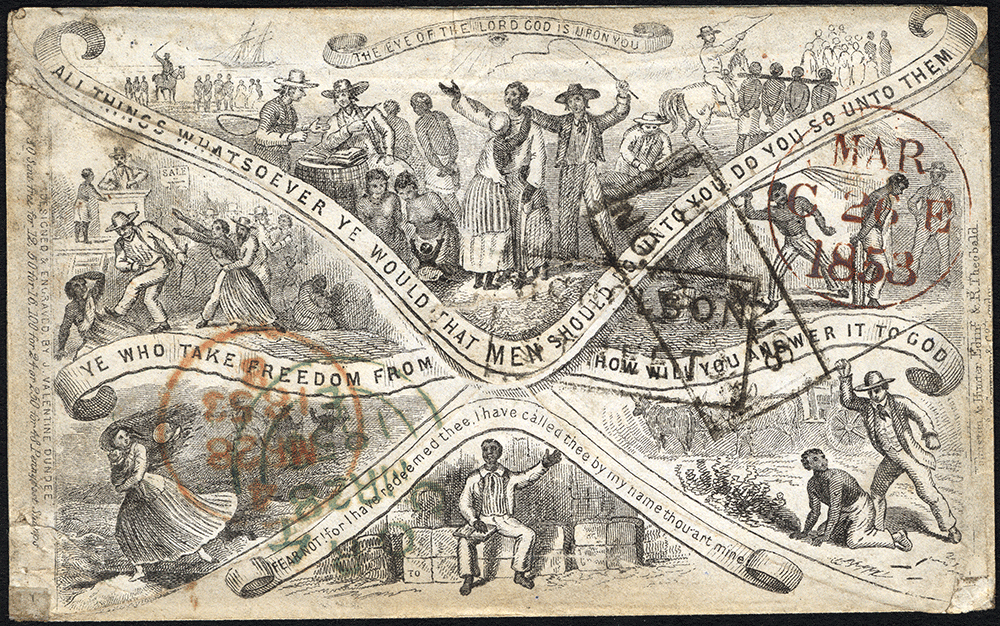 Uncle Tom’s Cabin illustrated anti-slavery cover, March 28, 1853
Less than a year after its publication in the United States, Uncle Tom’s Cabin sold more than one million copies in Great Britain. Although modern critics point out the book’s use of racially stereotyped characters, in its day it was regarded as a powerful piece of anti-slavery propaganda. Scenes from the novel decorate the reverse of this British anti-slavery cover published by James Valentine of Dundee, Scotland.
Uncle Tom’s Cabin illustrated anti-slavery cover, March 28, 1853
Less than a year after its publication in the United States, Uncle Tom’s Cabin sold more than one million copies in Great Britain. Although modern critics point out the book’s use of racially stereotyped characters, in its day it was regarded as a powerful piece of anti-slavery propaganda. Scenes from the novel decorate the reverse of this British anti-slavery cover published by James Valentine of Dundee, Scotland.
The scenes, clockwise from top flap: Uncle Tom is sold away from Aunt Chloe and his children because of his owner’s bankruptcy. The overseers Sambo and Quimbo flog Uncle Tom. Simon Legree whips Uncle Tom. Uncle Tom reads his Bible atop cotton bales on a Mississippi River steamboat. Pursued by slave catchers, Eliza escapes north with her five year old son Harry. Emmeline is sold away from her grieving mother, Susan.
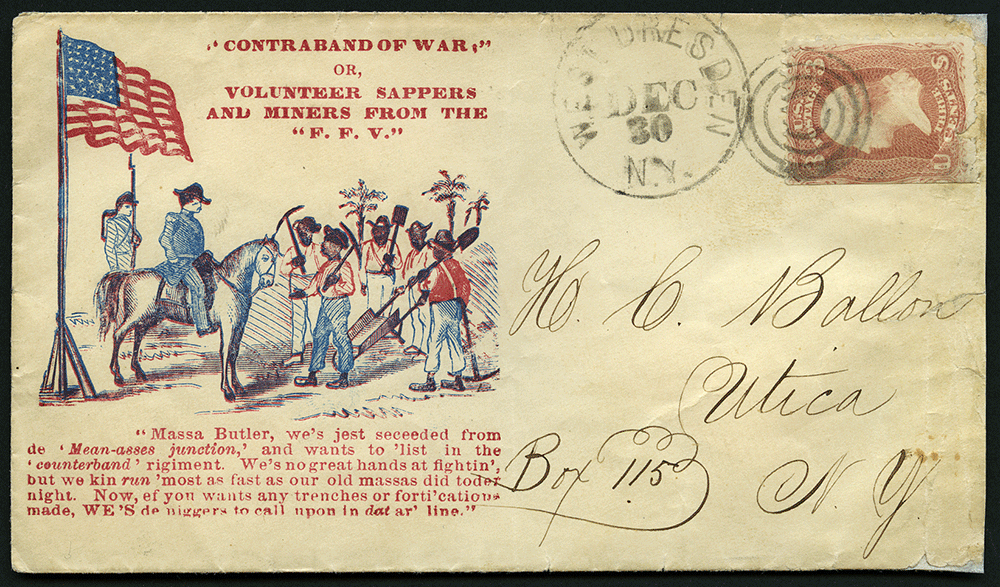 Runaway slaves volunteering for Union army illustrated cover, c. 1861
Runaway slaves volunteering for Union army illustrated cover, c. 1861
Early in the Civil War, Union General Benjamin Butler decreed that escaped slaves who reached his station at Fort Monroe would be considered “contraband” and not returned to their owners. Although the idea of black troops is caricatured by these envelopes, nearly 200,000 black men served in the Union forces.
 William H. Carney Medal of Honor, 1900
William H. Carney Medal of Honor, 1900
William Harvey Carney, born a slave in Virginia in 1840, volunteered for the celebrated, all-black 54th Massachusetts Volunteer Infantry Regiment. Shot twice while rescuing the American flag during an attack on Battery Wagner near Charleston, South Carolina, he later received the Medal of Honor. After the war, he worked as a letter carrier in the New Bedford, Massachusetts post office for more than thirty years.
Loan from Carl J. Cruz
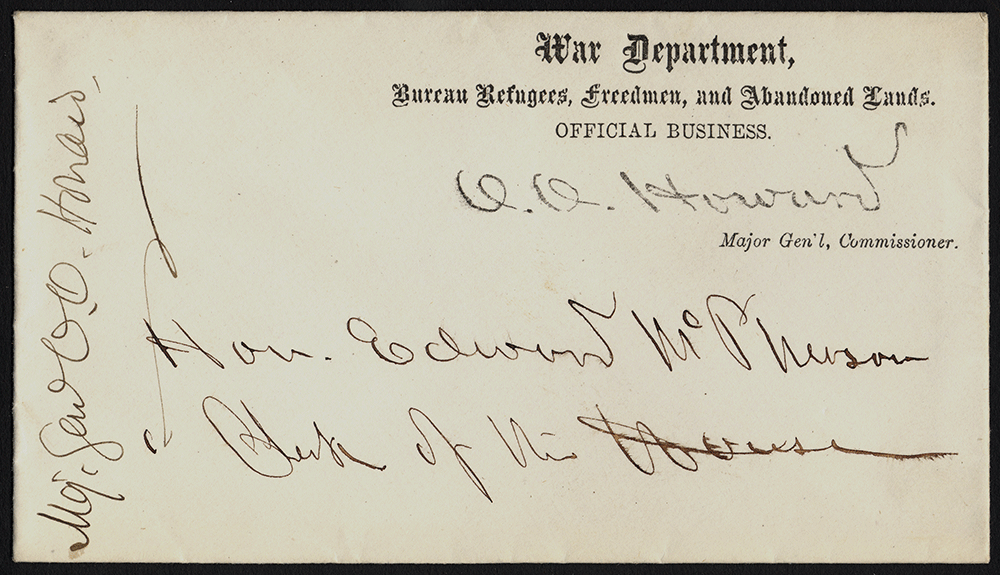 Freedmen’s Bureau cover, c. 1865-1872
Freedmen’s Bureau cover, c. 1865-1872
Private charity could only partially meet former slaves’ needs, which ranged from food and clothing to employment and education. Congress created the Freedmen’s Bureau in 1865 with Major General Oliver O. Howard as its commissioner. A Medal of Honor recipient, he later served as president of Howard University. His signature indicated that no postage was due.
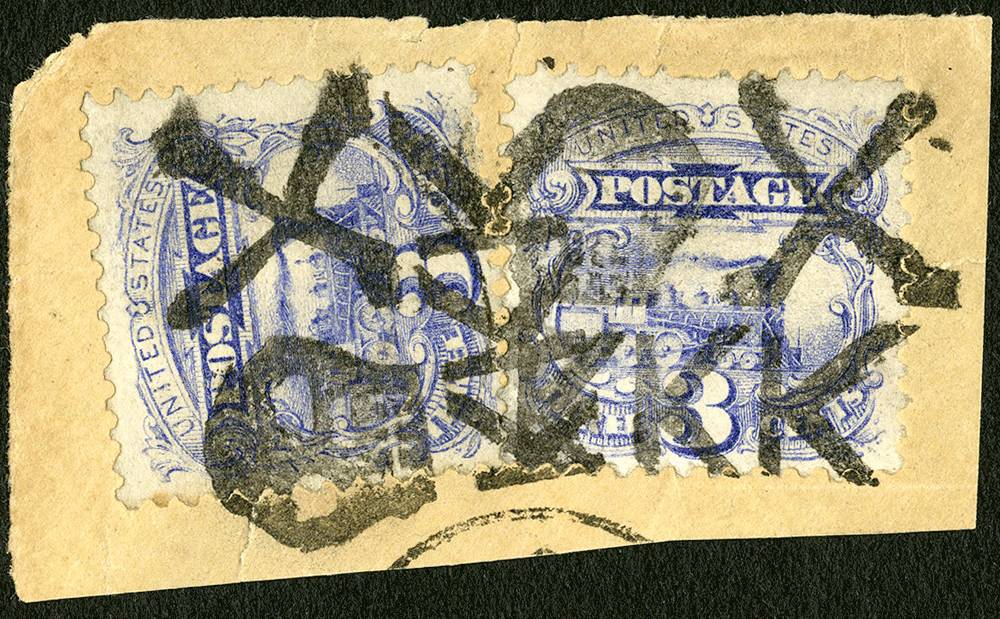 ‘Skull and Crossbones’ KKK postal cancel, Union Mills, Pennsylvania, c. 1870
The skull and crossbones was one of the earliest symbols adopted by the Klan.
Loan from Stampvestors LLC through Columbian Stamp Company
‘Skull and Crossbones’ KKK postal cancel, Union Mills, Pennsylvania, c. 1870
The skull and crossbones was one of the earliest symbols adopted by the Klan.
Loan from Stampvestors LLC through Columbian Stamp Company
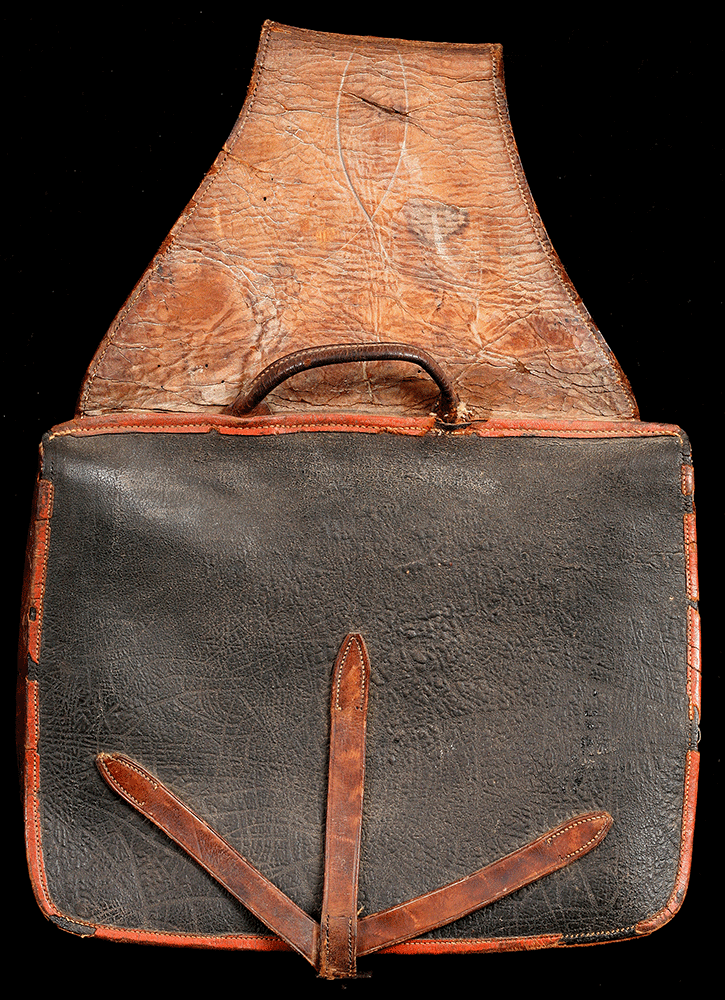 Segregated Rural Free Delivery saddlebag, c. 1896
Palmyra, Virginia became a Rural Free Delivery post office on October 22, 1896, one of the first in the nation to deliver mail to farm families. This mailbag with separate compartments for “white” and “colored” mail was not required by federal policy but was procured by the carrier to satisfy either his own preferences or those of his customers.
Segregated Rural Free Delivery saddlebag, c. 1896
Palmyra, Virginia became a Rural Free Delivery post office on October 22, 1896, one of the first in the nation to deliver mail to farm families. This mailbag with separate compartments for “white” and “colored” mail was not required by federal policy but was procured by the carrier to satisfy either his own preferences or those of his customers.
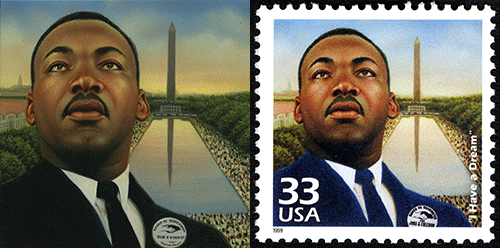 33c Martin Luther King Jr. approved stamp art by Keith Birdsong, c. 1999
33c Martin Luther King Jr. approved stamp art by Keith Birdsong, c. 1999
Martin Luther King’s I Have a Dream speech was commemorated in the Postal Service’s Celebrate the Century stamp series issued at the end of the twentieth century. A trace of brightness on the horizon represents hope, while King wears the March’s official badge.
Loan from the United States Postal Service, Postmaster General’s Collection
37c Marian Anderson approved stamp art by Albert Slark, c. 2005
Canadian-born artist Albert Slark created this full-color oil portrait of Marian Anderson from a circa 1934 black-and-white photograph. Easily one of the most beautiful designs in the Black Heritage series, it won numerous awards and was exhibited at the Society of Illustrators 48th Annual Exhibition in New York City.
 22c Duke Ellington approved stamp art by Jim Sharpe, c. 1986
22c Duke Ellington approved stamp art by Jim Sharpe, c. 1986
Performing Arts Series
The most prolific jazz composer ever, Edward ‘Duke’ Ellington and his orchestra toured the U.S. for nearly fifty years and also popularized the genre in Europe.




Pingback: Black Heritage: Robert Robinson Taylor | virtualstampclub.com